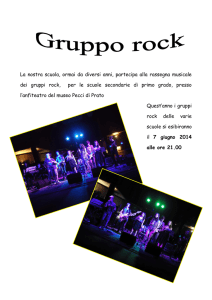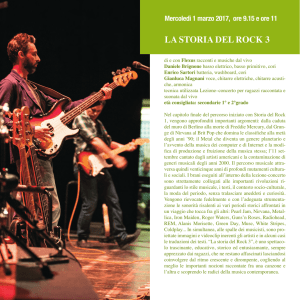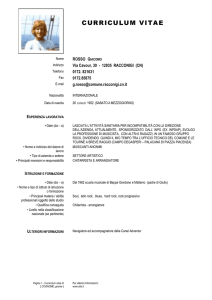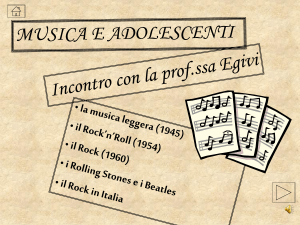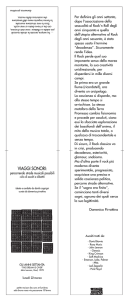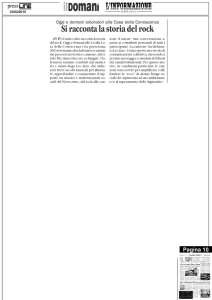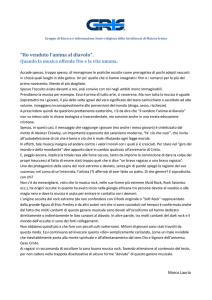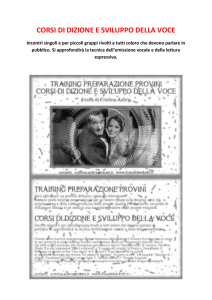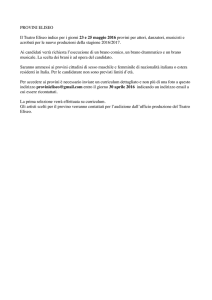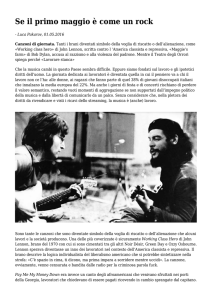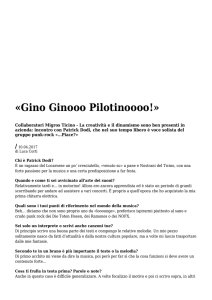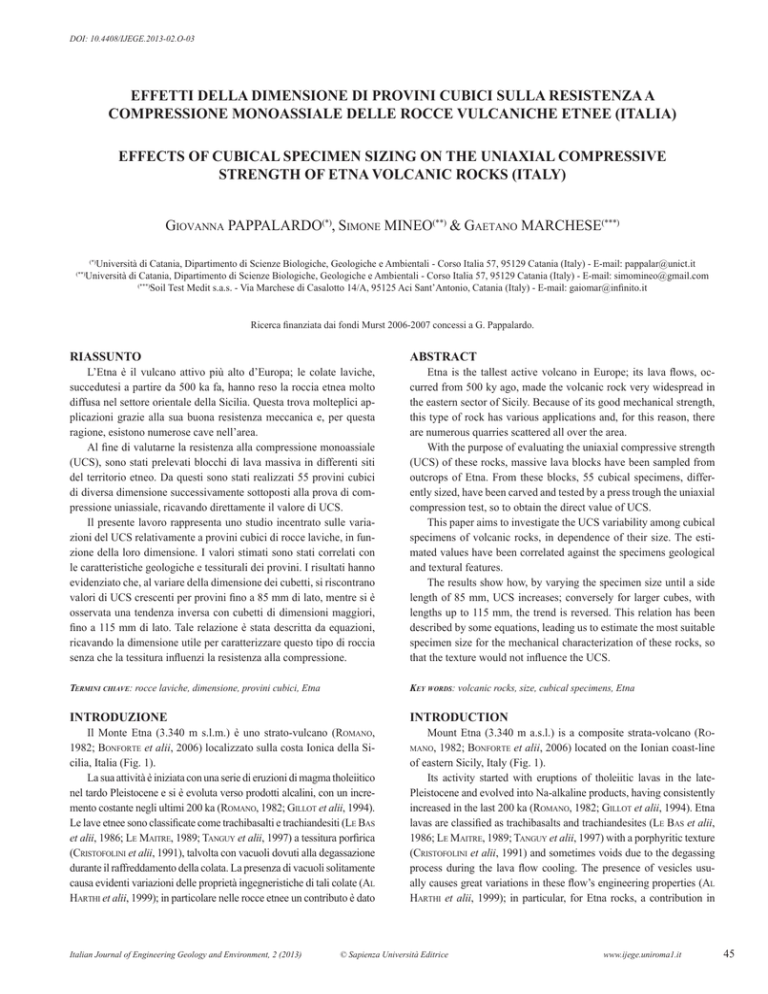
DOI: 10.4408/IJEGE.2013-02.O-03
EFFETTI DELLA DIMENSIONE DI PROVINI CUBICI SULLA RESISTENZA A
COMPRESSIONE MONOASSIALE DELLE ROCCE VULCANICHE ETNEE (ITALIA)
EFFECTS OF CUBICAL SPECIMEN SIZING ON THE UNIAXIAL COMPRESSIVE
STRENGTH OF ETNA VOLCANIC ROCKS (ITALY)
Giovanna PAPPALARDO(*), Simone MINEO(**) & Gaetano MARCHESE(***)
(*)
Università di Catania, Dipartimento di Scienze Biologiche, Geologiche e Ambientali - Corso Italia 57, 95129 Catania (Italy) - E-mail: [email protected]
Università di Catania, Dipartimento di Scienze Biologiche, Geologiche e Ambientali - Corso Italia 57, 95129 Catania (Italy) - E-mail: [email protected]
(***)
Soil Test Medit s.a.s. - Via Marchese di Casalotto 14/A, 95125 Aci Sant’Antonio, Catania (Italy) - E-mail: [email protected]
(**)
Ricerca finanziata dai fondi Murst 2006-2007 concessi a G. Pappalardo.
RIASSUNTO
ABSTRACT
Termini chiave: rocce laviche, dimensione, provini cubici, Etna
Key words: volcanic rocks, size, cubical specimens, Etna
INTRODUZIONE
INTRODUCTION
L’Etna è il vulcano attivo più alto d’Europa; le colate laviche,
succedutesi a partire da 500 ka fa, hanno reso la roccia etnea molto
diffusa nel settore orientale della Sicilia. Questa trova molteplici applicazioni grazie alla sua buona resistenza meccanica e, per questa
ragione, esistono numerose cave nell’area.
Al fine di valutarne la resistenza alla compressione monoassiale
(UCS), sono stati prelevati blocchi di lava massiva in differenti siti
del territorio etneo. Da questi sono stati realizzati 55 provini cubici
di diversa dimensione successivamente sottoposti alla prova di compressione uniassiale, ricavando direttamente il valore di UCS.
Il presente lavoro rappresenta uno studio incentrato sulle variazioni del UCS relativamente a provini cubici di rocce laviche, in funzione della loro dimensione. I valori stimati sono stati correlati con
le caratteristiche geologiche e tessiturali dei provini. I risultati hanno
evidenziato che, al variare della dimensione dei cubetti, si riscontrano
valori di UCS crescenti per provini fino a 85 mm di lato, mentre si è
osservata una tendenza inversa con cubetti di dimensioni maggiori,
fino a 115 mm di lato. Tale relazione è stata descritta da equazioni,
ricavando la dimensione utile per caratterizzare questo tipo di roccia
senza che la tessitura influenzi la resistenza alla compressione.
Il Monte Etna (3.340 m s.l.m.) è uno strato-vulcano (Romano,
1982; Bonforte et alii, 2006) localizzato sulla costa Ionica della Sicilia, Italia (Fig. 1).
La sua attività è iniziata con una serie di eruzioni di magma tholeiitico
nel tardo Pleistocene e si è evoluta verso prodotti alcalini, con un incremento costante negli ultimi 200 ka (Romano, 1982; Gillot et alii, 1994).
Le lave etnee sono classificate come trachibasalti e trachiandesiti (Le Bas
et alii, 1986; Le Maitre, 1989; Tanguy et alii, 1997) a tessitura porfirica
(Cristofolini et alii, 1991), talvolta con vacuoli dovuti alla degassazione
durante il raffreddamento della colata. La presenza di vacuoli solitamente
causa evidenti variazioni delle proprietà ingegneristiche di tali colate (Al
Harthi et alii, 1999); in particolare nelle rocce etnee un contributo è dato
Italian Journal of Engineering Geology and Environment, 2 (2013)
Etna is the tallest active volcano in Europe; its lava flows, occurred from 500 ky ago, made the volcanic rock very widespread in
the eastern sector of Sicily. Because of its good mechanical strength,
this type of rock has various applications and, for this reason, there
are numerous quarries scattered all over the area.
With the purpose of evaluating the uniaxial compressive strength
(UCS) of these rocks, massive lava blocks have been sampled from
outcrops of Etna. From these blocks, 55 cubical specimens, differently sized, have been carved and tested by a press trough the uniaxial
compression test, so to obtain the direct value of UCS.
This paper aims to investigate the UCS variability among cubical
specimens of volcanic rocks, in dependence of their size. The estimated values have been correlated against the specimens geological
and textural features.
The results show how, by varying the specimen size until a side
length of 85 mm, UCS increases; conversely for larger cubes, with
lengths up to 115 mm, the trend is reversed. This relation has been
described by some equations, leading us to estimate the most suitable
specimen size for the mechanical characterization of these rocks, so
that the texture would not influence the UCS.
Mount Etna (3.340 m a.s.l.) is a composite strata-volcano (Ro1982; Bonforte et alii, 2006) located on the Ionian coast-line
of eastern Sicily, Italy (Fig. 1).
Its activity started with eruptions of tholeiitic lavas in the latePleistocene and evolved into Na-alkaline products, having consistently
increased in the last 200 ka (Romano, 1982; Gillot et alii, 1994). Etna
lavas are classified as trachibasalts and trachiandesites (Le Bas et alii,
1986; Le Maitre, 1989; Tanguy et alii, 1997) with a porphyritic texture
(Cristofolini et alii, 1991) and sometimes voids due to the degassing
process during the lava flow cooling. The presence of vesicles usually causes great variations in these flow’s engineering properties (Al
Harthi et alii, 1999); in particular, for Etna rocks, a contribution in
mano,
© Sapienza Università Editrice
www.ijege.uniroma1.it
45
EFFETTI DELLA DIMENSIONE DI PROVINI CUBICI SULLA RESISTENZA A COMPRESSIONE MONOASSIALE DELLE ROCCE VULCANICHE ETNEE (ITALIA)
Fig. 1 - Localizzazione geografica e geologia dell’area di studio. Formazione Torre del Filosofo: colate laviche aa, coni di scorie e depositi piroclastici di caduta
con composizione variabile da basaltica a mugearitica; Formazione Pietracannone: colate laviche, coni di scorie e depositi piroclastici di caduta con composizione variabile da basaltica a benmoreitica; Formazione Valverde: colate laviche intercalate a sottili depositi epiclastici con composizioni variabili da
hawaiitica a mugearitica; Formazione Timpa: colate laviche, coni di scorie e depositi vulcanoclastici con composizioni variabili da basaltica a mugearitica;
Formazione Acicastello: vulcaniti tholeiitiche sottomarine e lave a pillow; Complesso sedimentario: argille grigio-azzurre
- Geographical location and geology of the study area. Torre del Filosofo Formation: aa lava flows, scoria cones and pyroclastic fall deposits with composition ranging from basalt to mugearite; Pietracannone Formation: lava flows, scoria cones and pyroclastic fall deposits with composition ranging from basalt to benmoreite; Valverde Formation: lava flows interbedded with thin epiclastic deposits with composition ranging from hawaiite to mugearite; Timpa
Formation: lava flows, scoria deposits and volcanoclastic deposits with composition ranging from basalt to mugearite; Acicastello Formation: submarine
volcanic tholeiitic and pillow lava; Sedimentary Complex: blue-grey marly clays
dalla microporosità della pasta di fondo. Grazie alla loro abbondanza (le
colate laviche ricoprono una superficie di circa 1.260 km2), i prodotti
etnei sono spesso usati come aggregati e materiale da costruzione in diversi contesti della Sicilia ed esistono numerose cave distribuite su tutta
l’area. Il presente lavoro ha come obiettivo lo studio delle variazioni del
UCS, relativamente alle rocce etnee, in dipendenza della dimensione di
55 provini di forma cubica. La resistenza a compressione monoassiale
(UCS) è uno dei principali parametri geomeccanici utilizzati per caratterizzare la roccia e classificare un ammasso roccioso (Hoek & Brown,
1980; Hudson & Harrison, 1997; Tuncay & Hasancebi, 2009). Questa
è considerata come una delle proprietà “chiave” nella caratterizzazione
di materiali rocciosi nell’ambito ingegneristico (Basu & Aydin, 2006) e
come la proprietà geotecnica più quotata nell’ingegneria applicata alle
46
given by the microporosity of groundmass. Because of their abundance
(lava flows cover about 1,260 km2), Etna’s products are used as aggregates and construction material in many different sites of Sicily, and
there are numerous quarries scattered throughout the whole area.
This paper aims to investigate the UCS variability among 55 cubical specimens of Etna rocks, in dependence of their size.
The uniaxial compressive strength (UCS) of a rock material is
one of the basic geomechanical parameters used to characterize the
rock and to determine the rock mass classification (Hoek & Brown,
1980; Hudson & Harrison, 1997; Tuncay & Hasancebi, 2009). It is
considered as one of the key properties in characterization of rock
materials in engineering practice (Basu & Aydin, 2006) and the geotechnical property that is most often quoted in rock engineering prac-
G. PAPPALARDO, S. MINEO & G. MARCHESE
EFFECTS OF CUBICAL SPECIMEN SIZING ON THE UNIAXIAL COMPRESSIVE STRENGTH OF ETNA VOLCANIC ROCKS (ITALY)
rocce (Rusnak & Mark, 2000). Le prove che consentono di stimare la
resistenza di una roccia seguono procedure ben precise che sono state
standardizzate dalle International Society for Rock Mechanics (ISRM,
1979), American Society for Testing and Materials (ASTM, 1984) e UNI
EN 1926:2007. Mentre le prime due normative prendono in considerazione esclusivamente provini di forma cilindrica, l’ultima ammette prove
di compressione uniassiale anche su provini cubici.
Molti sono gli autori che si sono occupati delle variazioni della
resistenza a compressione uniassiale delle rocce (Torok & Vasarhelyi,
2010) in base alla loro dimensione. La Comunità Scientifica è concorde
nell’affermare che esiste una relazione che leghi UCS e dimensione
dei campioni. John (1972), indagando sul comportamento meccanico
di campioni arenitici, ha notato che i valori di resistenza sono approssimativamente invariabili quando le carote presentano un rapporto
altezza:diametro pari a 2:1 o superiore, invece se questo rapporto diminuisce si registra un notevole incremento della resistenza apparente
(Hawkins, 1998). Goodman (1989) parla di un effetto dimensione derivante da un incremento della resistenza man mano che le dimensioni del provino diminuiscono (Alehossein & Boland 2004). Risultati
analoghi sono stati presentati da Hoskins & Horino (1969), Hoek &
Brown (1980), Jackson & Lau (1990), Hawkins (1998), Darlington
et alii (2011). È importante specificare che la maggior parte dei dati
presentati da questi autori riguarda esclusivamente provini di forma
cilindrica, invece il presente studio prende in considerazione provini
cubici. Hoek & Brown (1980) hanno raccolto dalla letteratura una serie
di valori di resistenza relativi a rocce differenti e li hanno rappresentati
su un diagramma mostrando come la resistenza a compressione monoassiale diminuisca con l’aumentare delle dimensioni del provino.
Hawkins (1998) specifica però che il diagramma di Hoek concerne
dati relativi a provini di forma sia cilindrica sia cubica, che la maggior
parte dei campioni sono rocce cristalline e che soltanto uno dei dieci provini è rappresentato da una roccia sedimentaria. Di conseguenza questo
non può essere considerato rappresentativo di tutte le rocce. Per questo
motivo l’autore ha eseguito alcune prove su 7 tipi di rocce sedimentarie
con 8 differenti diametri, tutti con rapporto altezza:diametro pari a 2:1. I
risultati mostrano che il valore massimo di resistenza è stato ottenuto su
carote con diametro di circa 40-60 mm ma, a differenza dei risultati di
Hoek e Brown, i più bassi valori di UCS sono stati registrati sia nei provini a diametro maggiore, sia in quelli a diametro minore (Hawkins, 1998).
Obert et alii (1946) e Hodgson & Cook (1970) invece non hanno
rilevato nessuna variazione della resistenza al variare delle dimensioni
del provino, mentre Mogi (1962), Protodyakonov & Koifman (1963),
Bieniawski (1972), Pratt et alii (1972), hanno anch’essi ottenuto riduzioni significative della resistenza con l’aumentare delle dimensioni del
campione (Tuncay & Hasancebi, 2009).
In particolare, per i basalti, Tuncay & Hasancebi (2009) hanno ottenuto un decremento del UCS legato all’incremento del rapporto L:D
per tutte le rocce analizzate eccetto il tufo. Essi inoltre hanno registrato
un’elevata deviazione standard, la quale potrebbe essere legata alla presenza di vuoti visibili (fino a 5 mm).
Italian Journal of Engineering Geology and Environment, 2 (2013)
tice (Rusnak & Mark, 2000).
The testing procedures which allow estimating a rock strength
have been suggested by the International Society for Rock Mechanics (ISRM, 1979), the American Society for Testing and Materials
(ASTM, 1984) and UNI EN 1926:2007. While the first two regulations concern only cylindrical specimens, the last one specifies that
uniaxial compression tests can be carried out also on cubes.
Several authors have already investigated rock strength (i.e.
uniaxial compressive strength) variations (Torok & Vasarhelyi,
2010) with respect to the sample size. Scientific Community agrees
that a relation between UCS and specimen size does exist. John
(1972), pointing out the mechanical behavior of dry sandstone samples, noticed that the obtained strengths are approximately the same
when the cores have a height: diameter ratio of 2:1 or greater, but
if the ratio is smaller there is a notable increase in the apparent
strength (Hawkins, 1998). Goodman (1989) talks about the existence of a size effect, resulting in an increase of strength values as
the specimen size decreases (Alehossein & Boland 2004). Hoskins
& Horino (1969), Hoek & Brown (1980), Jackson & Lau (1990),
Hawkins (1998), Darlington et alii (2011), have all investigated
the influence of specimen size on the strength of intact rock reaching the same conclusion. It is important to specify that most data
presented by those authors concern only cylindrical shape samples,
while this paper refers on cubical specimens. Hoek & Brown (1980)
put together many strength measurement data taken from the literature for different rock types and plotted them on a diagram, showing
how UCS is lower for larger specimens.
But Hawkins (1998) specifies that Hoek’s diagram includes data
obtained on both cores and cube samples, that the majority of the
specimens are of crystalline material, and that only one of the ten
samples is of a sedimentary rock (limestone). As a consequence, it
is unlikely that the diagram is representative of rocks in general. For
this reason he performed tests on 7 types of sedimentary rocks at
8 different diameters with a 2:1 height: diameter ratio. The results
showed that the maximum strengths of the sedimentary samples
were obtained on cores of approximately 40-60 mm diameter but,
unlike Hoek and Brown’s results, the UCS values are lower for both
the larger and smaller diameter cylinders (Hawkins, 1998).
Obert et alii (1946) and Hodgson & Cook (1970) reported no
change in rock strength with specimen size, while Mogi (1962), Protodyakonov & Koifman (1963), Bieniawski (1972), Pratt et alii
(1972) also obtained significant strength reductions with increasing
specimen size (Tuncay & Hasancebi, 2009).
For basalts, in particular, Tuncay & Hasancebi (2009) obtained a
decrease in UCS values with increasing L:D ratios for all rock types
except tuff. Moreover they found a high standard deviation value,
which is likely to be related to the visible voids (up to 5 mm).
© Sapienza Università Editrice
www.ijege.uniroma1.it
47
EFFETTI DELLA DIMENSIONE DI PROVINI CUBICI SULLA RESISTENZA A COMPRESSIONE MONOASSIALE DELLE ROCCE VULCANICHE ETNEE (ITALIA)
Fig. 2 - Sezioni sottili rappresentative delle rocce studiate: particolare di fenocristalli di plagioclasio Pl (a) ed olivina Ol (b)
- Representative thin sections of studied rocks: detail of plagioclase Pl (a) and olivine Ol (b) phenocrysts
MATERIALI E METODI
La ricerca ha riguardato prove di schiacciamento su un totale di 55
provini di forma cubica, i quali hanno lunghezze degli spigoli (L) variabili da 30 mm a 115 mm e sono stati ricavati da blocchi prelevati in cave
del settore sud-orientale dell’Etna. Si è scelto di conferire ai provini una
forma cubica poiché è quella più pratica da realizzare partendo da blocchi irregolari, soprattutto se si necessitano provini di grandi dimensioni.
Tutti i provini presentano un’omogeneità dal punto di vista petrografico sia per la tessitura sia per il contenuto mineralogico, sebbene
appartengano a formazioni geologiche differenti. La tessitura è porfirica, con una paragenesi data da plagioclasi, augite e olivina (Fig. 2)
immersi in una pasta di fondo microcristallina, raramente vitrofirica,
con presenza di microvuoti.
Nello specifico i 55 campioni ricadono nelle due formazioni maggiormente rappresentative: Torre del Filosofo (122 A.C.- 1971 d.C.)
e Pietracannone (membri superiore ed inferiore; 15 ka - 122 A.C.)
(Branca et alii, 2011) (Fig. 1). Generalmente la differenza principale
tra le due formazioni riguarda i range composizionali, che però sembrano, come si vedrà in seguito, non influenzare il valore di resistenza
alla compressione monoassiale. Altra caratteristica dei campioni analizzati è la presenza di vuoti e micropori dovuti alla rapida degassazione del magma. Questi definiscono la porosità di tali rocce, stimata,
in questo lavoro, attraverso metodi empirici (UNI EN 1936, 2007).
Infatti la presenza di vuoti non comunicanti all’interno della roccia,
rende i convenzionali test di laboratorio non appropriati, poiché l’acqua non riesce a penetrare nei vuoti non connessi e quindi il provino
sarà saturato solo parzialmente (Al Harthi et alii, 1999).
La resistenza a compressione uniassiale (UCS) è stata determinata a mezzo di prove di schiacciamento monoassiale, secondo le
specifiche UNI EN 1926:2007. Tali prove sono state eseguite con
una pressa con capacità di carico di 300 tons, provvista di celle di
48
MATERIALS AND METHODS
The investigation involved tests on a total of 55 cubical specimens, which have side lengths ranging from 30 mm to 115 mm and
were carved from blocks taken in quarries scattered in the south-eastern sector of Etna volcano. These specimens have been given a cubical shape because it is the most practical to realize from an irregular
block, especially when large cubes are required.
All specimens are characterized by homogeneous petrographic
features with respect to both the texture and the mineral content, although they belong to different geological formations. They show a
porphyritic texture given by plagioclase, augite and olivine (Fig. 2)
in an usually completely crystallized groundmass, rarely vitrophyric,
with the presence of microvoids.
In particular the 55 specimens belong to the two most representative formations: Torre del Filosofo (122 B.C.- 1971 A.D.) and Pietracannone (upper and lower member; 15 ky - 122 B.C.) (Branca et
alii, 2011) (Fig. 1).
Generally the main difference between the two formations is the
compositional range, which seems not to affect the uniaxial compressive strength, as demonstrated below.
Another feature of the analyzed specimens is the presence of voids
and micropores due to magma degassing. This represents the porosity
which has been estimated, in this paper, by empirical methods (UNI
EN 1936, 2007). In fact the presence of non-connected voids inside
this kind of rock, makes the conventional laboratory tests unsuitable,
because water will never fill the non-connected voids and the sample
will only be partially saturated (Al Harthi et alii, 1999).
The Unconfined Compressive Strength (UCS) has been determined through uniaxial compression tests, according to UNI EN
1926:2007 recommendations. The tests have been performed by a
press with a load capacity of 300 tons, provided with load cells con-
G. PAPPALARDO, S. MINEO & G. MARCHESE
EFFECTS OF CUBICAL SPECIMEN SIZING ON THE UNIAXIAL COMPRESSIVE STRENGTH OF ETNA VOLCANIC ROCKS (ITALY)
carico e collegata ad un sistema di acquisizione automatico presso
nected to an automatic loads registration system, at Soil Test Medit
il laboratorio Soil Test Medit s.a.s. nella città di Catania (Sicilia).
s.a.s. laboratory in Catania (Sicily). This test has the purpose of estiQuesto tipo di prova ha lo scopo di stimare il valore di resistenza a
mating the failure strength measured value on specimens loaded axirottura di un provino sottoposto ad un carico assiale. È un metodo
ally. It is a simple and versatile method for determining material propsemplice e versatile per determinare le proprietà del materiale in
erties in almost all kinds of material applications (Bradley et alii,
quasi tutte le applicazioni pratiche (Bradley et alii, 2001). Di solito
2001). Usually, the load on the specimen is applied so as to produce
il carico viene applicato in modo da produrre un tasso di deformaa uniform strain rate. The movement of the piston is hydraulically
zione costante. Il movimento del pistone è controllato idraulicamencontrolled to ensure that the loaded end is deformed at the required
te in modo tale da assicurare un carico costante (1±0,5 MPa/sec in
constant rate (1±0.5 MPa/sec in this case), thus causing an uniform
questo caso) (Das & Cleary, 2006).
longitudinal strain in the specimen (Das & Cleary, 2006).
Il valore di UCS non è altro che il rapporto tra il carico massimo a
UCS is the ratio of the maximum stress registered during the test
rottura registrato (Pmax) e l’area iniziale del provino (A0):
(Pmax) to the initial area of the specimen (A0):
UCS = Pmax/A0
I valori di densità, rappresentativi del tipo di roccia in esame, sono
stati determinati seguendo le procedure UNI EN 1936:2001. Il valore
di densità medio è di 2730 kg/m3, con una deviazione standard di 170.
La bassa deviazione standard è indice della similitudine dei provini
dal punto di vista delle caratteristiche petrografiche e della tessitura.
I valori di UCS variano da un minimo di 37,49 MPa ad un massimo di 170,89 MPa con una media di 111,39 MPa (± 28,99). La
deviazione standard della media (28,99) dimostra che il dataset presenta un’ampia varietà di valori e ciò potrebbe essere legato alla
presenza di vuoti (micro e macroporosità), in accordo con Tuncay
e Hasancebi (2009).
The density values, which are representative of rock type, have
been estimated in accordance with UNI EN 1936 recommendation.
The average density value is 2730 kg/m3, with a standard deviation
of 170. The low standard deviation means that all specimens were
similar in petrographic features and texture.
UCS values range from a minimum of 37.49 MPa to a maximum of 170.89 MPa with an average of 111.39 MPa (± 28.99). The
standard deviation (28.99) shows how the dataset is characterized
by a wide range of values and it is likely to be related to the presence of voids (micro and macroporosity) in accordance to Tuncay
& Hasancebi (2009).
RISULTATI
RESULTS
Al fine di osservare le variazioni del UCS con la dimensione,
sono stati correlati i valori di UCS con la lunghezza degli spigoli (L)
dei provini cubici. Considerando l’intero dataset la relazione restituita è di tipo polinomiale (Fig. 3).
With the aim of examining the UCS variations with respect to the
specimen size, UCS values have been correlated to the side lengths
(L) values. Considering the whole dataset the resulting relation is
polynomial type (Fig. 3).
Fig. 3 - Andamento del UCS in funzione della dimensione dei provini; le barre di errore indicano
la deviazione standard; i numeri indicano il
numero di provini per ciascuna L
- UCS distribution with respect to the specimens
size; error bars indicate the standard deviation; numbers indicate the number of specimens for each L
Italian Journal of Engineering Geology and Environment, 2 (2013)
© Sapienza Università Editrice
www.ijege.uniroma1.it
49
EFFETTI DELLA DIMENSIONE DI PROVINI CUBICI SULLA RESISTENZA A COMPRESSIONE MONOASSIALE DELLE ROCCE VULCANICHE ETNEE (ITALIA)
L’andamento della curva in figura 3 mostra come i valori più bassi
di UCS sono legati a cubetti piccoli e grandi, analogamente all’esperienza di Hawkins (1998). Infatti ai due estremi si ritrovano i valori
minimi di UCS (37,49 MPa e 78,25 MPa) relativamente a L=30,8
mm e L=112 mm. Il valore massimo registrato è di 170,89 MPa ed è
riferito ad un provino di 82,2 mm di lato. Inoltre si può notare che i
gruppi con i più bassi valori di devazione standard sono quelli con 45,
75, 95 e 105 mm di lato.
In figura 3 è ulteriormente possibile discernere due serie differenti: la prima include provini con 30 mm < L < 85 mm, la seconda
provini con 85 mm < L< 115 mm. Il valore di scissione L=85 mm è
risultato essere il più appropriato poiché in questo modo si ottengono
i più alti valori di R2 fra tutte le relazioni vagliate in fase di studio.
The curve trend in figure 3 shows how the UCS lowest values are
related both to smallest and largest cubes, in accordance to Hawkins’s
experience (1998). In fact it is possible to recognize, at the two extremities, the minimum UCS values (37.49 MPa and 78.25 MPa) respectively related to L=30.8 mm e L=112 mm. The maximum UCS
value is 170.89 MPa and belongs to a sample of 82.2 mm. Furthermore the groups with the lowest standard deviation are those with
side lengths of 45, 75, 95 and 105 mm.
In figure 3 two different series are likely to be discerned: the first one
includes specimens with 30 mm < L < 85 mm, the second one specimens
with 85 mm < L < 115 mm. The division L value of 85 mm, is found to
be the most appropriate because in this way it is possible to obtain the
highest R2 among the numerous relations considered during the study.
Fig. 4 - Correlazioni lineari per provini con L < 85 mm (a) e con L > 85 mm (b)
- Linear correlations for specimens with L < 85 mm (a) and L > 85 mm (b)
Fig. 5 - Correlazioni lineari per provini con L < 85 mm (a) e con L > 85 mm (b) in funzione della formazione geologica di appartenenza secondo Branca et alii (2011)
- Linear correlations for specimens with L < 85 mm (a) and L > 85 mm (b) with respect to the geological formation according to Branca et alii (2011)
50
G. PAPPALARDO, S. MINEO & G. MARCHESE
EFFECTS OF CUBICAL SPECIMEN SIZING ON THE UNIAXIAL COMPRESSIVE STRENGTH OF ETNA VOLCANIC ROCKS (ITALY)
Nel caso di cubetti con 30 mm < L < 85 mm si osserva che i valori
di UCS aumentano proporzionalmente ad L, secondo una relazione lineare (y = 1,7106x + 13,304) con un R2 di 0,77 (Fig. 4a). Invece I cubetti più grandi (85 mm < L < 115 mm) si comportano diversamente,
con valori di UCS decrescenti per L crescenti, secondo una relazione
lineare negativa (y = -2,6935x + 383,31) con un R2 di 0,71 (Fig. 4b),
in accordo con la maggior parte dei dati di letteratura.
Inoltre si è presa in considerazione l’ipotesi che le correlazioni
potessero essere influenzate dal fatto che i provini appartenessero a
due formazioni geologiche differenti. Dai diagrammi che seguono
(Fig. 5) si evince che tale condizione non influenza affatto la distribuzione del UCS, infatti le correlazioni (con i dati divisi per formazione) sono pressocchè le stesse.
In the case of cubes with 30 mm < L < 85 mm, UCS increases
with the increase of L, following a linear relation (y = 1.7106x
+ 13.304) with a R2 coefficient of 0.77 (Fig. 4a). Instead, larger
cubes (85 mm < L < 115 mm) behave differently, with UCS values decreasing while L increases, following a linear relation (y =
-2.6935x + 383.31) with a R2 coefficient of 0.71 (Fig. 4b), according to most literature data.
Furtehrmore, the hypotesis that the correlations could be affected by the different geological formational origin of the specimens
has been considered. The following graphics (Fig. 5) show that the
correlations (distinguishing specimens with respect to their geological formations) are almost the same, so this condition does not affect the UCS distribution.
DISCUSSIONI E CONCLUSIONI
DISCUSSIONS AND CONCLUSIONS
I risultati ottenuti mostrano che a parità di condizioni quali,
l’utilizzo della stessa pressa per tutte le prove, uniformità del carico applicato e caratteristiche petrografiche e tessiture simili, la
dimensione dei provini influisce sulla stima del UCS, in accordo
con la maggior parte dei dati di letteratura relativi a provini cilindrici. Si è visto come i valori più bassi di UCS sono relativi
sia ai cubetti più piccoli sia a quelli più grandi e che la diversa
appartenenza formazionale non ha nessuna influenza sulla distribuzione di dati.
In particolare l’UCS è legato anche all’omogeneità del provino alle varie dimensioni: al crescere di L varia la porosità, infatti
è stato notato come questa sia più alta nei cubi con L > 85 mm
(7,81%) e più bassa in quelli con L < 85 mm (3,14%); la dimensione dei minerali invece resta costante. Pertanto nel cubetto piccolo
il minerale occupa uno spazio rilevante e può essere considerato
come una discontinuità della roccia, infatti la normativa UNI EN
1926:2007 impone l’utilizzo di cubetti con dimensione minima
del lato di 50 mm. Avendo il minerale una resistenza più elevata
rispetto alla pasta di fondo, la rottura viene focalizzata al contatto
pasta di fondo-minerale e si propaga in tutto il cubetto. La resistenza a rottura registrata quindi è bassa. Man mano che L cresce, la distribuzione dei minerali farà si che il campione diventi
più omogeneo, dato che questo tipo di roccia non presenta alcuna
anisotropia (i.e. orientazione preferenziale di minerali). Quindi il
provino opporrà maggiore resistenza alla compressione. È questo
il caso del tratto iniziale della curva polinomiale, dove il trend è
positivo (cubetti con 30 mm < L< 85 mm). Con l’aumento di L
però cresce anche la porosità che, indebolendo la struttura, determina una riduzione della resistenza con l’aumentare delle dimensioni, quindi un trend della curva negativo (cubetti con 85 mm < L
< 115 mm). La figura 6 mostra le differenze macroscopiche tra un
cubetto con L=30 mm (Fig. 6a) ed uno con L=80 mm (Fig. 6b); in
particolare la dimensione dei minerali nel primo dà un contributo
più intenso rispetto al secondo, dove inoltre è presente un certo
numero di vacuoli.
Italian Journal of Engineering Geology and Environment, 2 (2013)
Considering that the same press machinery has been used for
all the tests, the load value has been applied uniformly and with
a constant rate on each sample, all the specimens had similar
and homogeneous petrographic features and texture, the reached
results show that the specimen size affects the UCS, according
to most literature data concerning cylindrical specimens. It has
been noticed how UCS is lower both for smallest and largest
cubes and the different formational belonging does not affect
data distribution.
In particular UCS is even connected to the homogeneity of the
specimen at the different sizes: as L increases, the porosity varies; in fact it has been noticed how it is higher in cubes with > 85
mm (7.81%) and lower in those with L < 85 mm (3.14%); instead
the mineral size does not change. Therefore in a small cube the
mineral has a significant role and it can be considered as a rock
discontinuity, in fact the regulation UNI EN 1926:2007 imposes
the usage of cubes with a side length not less than 50 mm. Since
the mineral is stronger than the groundmass, the failure occurs at
the contact groundmass-mineral and it propagates throughout the
whole specimen. So the failure strength is low. As L increases,
the distribution of minerals will make the specimen more homogeneous, since this kind of rock do not show any anisotropy (i.e.
preferential orientation of minerals). Therefore, the specimen will
offer a higher compressive strength. This is the case of the initial
part of the polynomial curve, where the trend is positive (cubes
with 30 mm < L < 85 mm). But at the same time the porosity
also increases, weakening the whole structure and determining a
strength reduction as L grows, so a negative curve trend (cubes
with 85 mm < L < 115 mm). The figure 6 shows the macroscopic
differences between cubes with L=30 mm (Fig. 6a) and L=80 mm
(Fig. 6b); in particular the mineral size in the first cube gives a
stronger contribute than in the second, where there is also a certain number of vesicles.
© Sapienza Università Editrice
www.ijege.uniroma1.it
51
EFFETTI DELLA DIMENSIONE DI PROVINI CUBICI SULLA RESISTENZA A COMPRESSIONE MONOASSIALE DELLE ROCCE VULCANICHE ETNEE (ITALIA)
Fig. 6 - Particolare di 2 cubetti a differente dimensione (a: L=30 mm, b:L=80 mm) di rocce laviche massive appartenenti alla colata del 1669 (Formazione Torre
del Filosofo). Si notano i fenocristalli di pirosseno (Px), olivina (Ol) e plagioclasio (Pl) e vacuoli (Vc)
- Detail of 2 differently sized cubes (a: L=30 mm, b:L=80 mm) of massive volcanic rocks belonging to the 1669 lava flow (Torre del Filosofo Formation).
Pyroxene (Px), olivine (Ol) and plagioclase (Pl) phenocrysts and vesicle (Vc) are visible
Pertanto esiste una soglia di grandezza, stimata per il dataset in
questione, oltre la quale la resistenza a rottura è controllata non più
dai minerali, ma dai macro e micro vuoti. Questa soglia coincide col
picco massimo della curva, quindi con un valore di L pari a 80±5 mm.
Questo ragionamento porta a fare una considerazione su quali
dimensioni definire standard per le prove di schiacciamento uniassiale su rocce laviche etnee, tenendo presente che la normativa UNI
EN 1926:2007 impone come condizione necessaria che la dimensione massima dei minerali sia almeno 10 volte inferiore a quella di L.
Nel caso di studio la dimensione massima dei pirosseni, talvolta, si
aggira intorno ai 5-6 mm; stando quindi alla normativa, un cubetto
con L=50-60 mm sarebbe idoneo. Si è visto però che l’influenza dei
minerali è ancora presente a queste dimensioni (il trend continua ad
essere positivo fino a L=85 mm per poi divenire negativo con L >
85 mm). Noi riteniamo invece che affinché i valori di UCS non siano influenzati né dai minerali né dai micro-vuoti, i candidati ideali,
relativamente a questo tipo di roccia e per la prova di compressione
uniassiale, siano cubetti con lati standard di 80±5 mm.
Therefore, there is a specimen size threshold, estimated for our dataset, beyond which the uniaxial compressive strength is no longer controlled by minerals, but by macro and microvoids. This threshold coincides with the curve maximum peak, so with a L value of 80±5 mm.
This reasoning leads to make a point on which specimen size
can be defined standard for uniaxial compression tests on Etna volcanic rocks, considering that the regulation UNI EN 1926:2007
imposes, as a necessary condition, that the maximum mineral size
is at least 10 times lower than L. In the study case the maximum
pyroxene size, for some specimens, is about 5-6 mm; then according to the regulation, a cube with L=50-60 mm should be suitable.
But it has been shown that the minerals influence is still present at
these dimensions (we have a trend which is positive until cubes with
L=85 mm and negative for cubes with L > 85 mm). With respect to
this kind of rocks, we are led to believe that the ideal candidates, for
the uniaxial compression test, are cubes with side lengths of 80±5
mm. In this way UCS values will not be influenced either by minerals or by microvoids.
RINGRAZIAMENTI
ACKNOWLEDGMENTS
Agli autori è gradito ringraziare l’Anonimo Revisore per i
suoi preziosi consigli tecnici e per aver fornito spunti interessanti
per lavori futuri.
52
The authors wish to thank the Anonymous Referee for his
valuable technical suggestions and for the provided hints for further studies.
G. PAPPALARDO, S. MINEO & G. MARCHESE
EFFECTS OF CUBICAL SPECIMEN SIZING ON THE UNIAXIAL COMPRESSIVE STRENGTH OF ETNA VOLCANIC ROCKS (ITALY)
OPERE CITATE / REFERENCES
ASTM American Society for Testing and Materials (1984) - Standard test method for unconfined compressive strength of intact rock core specimens. Soil and rock,
building stones: annual book of ASTM standards, 4.08, Philadelphia, Pennsylvania.
Al-Harthi A.A., Al-Hamri R.M. & Shehata W.M. (1999) - The porosity and engineering properties of vescicular basalt in Saudi Arabia. Engineering Geology, 54:
313-320.
Alehossein H & Boland J.N. (2004) - Strength, toughness, damage and fatigue of rock. SIF2004 Structural Integrity and Fracture. http://eprint.uq.edu.au/
archive/00000836.
Basu A. & Aydin A. (2006) - Predicting uniaxial compressive strength by point load test: significance of cone penetration. Rock Mech. Rock Engng., 39: 483-490.
Bonforte A., Branca S. & Palano M. (2006) - Geometric and kinematic variations along the active Pernicana fault: Implication for the dynamics of Mount Etna
NE flank (Italy). Journal of Volcanology and Geothermal Research, 160: 210-222.
Bieniawski Z.T. (1972) - Propagation of brittle fracture in rock. In: Proceedings of 10th symposium on rock mechanics, AIME: 409-427, New York.
Bradley G.L., Chang P.C. & McKenna G.B. (2001) - Rubber modeling using uniaxial test data. Journal of Applied Polymer Science, 81: 837-848.
Branca S., Coltelli M., Groppelli G. & Lentini F. (2011) - Geological map of Etna volcano, 1:50,000 scale. Ital.J.Geosci. (Boll.Soc.Geol.It.), 130: 265-291.
Cristofolini R., Corsaro R.A. & Ferlito C. (1991) - Variazioni petrochimiche nella successione etnea: un riesame in base ai nuovi dati da campioni di superficie e
da sondaggi. Acta Vulcanologia, 1: 25-37.
Darlington W.J. & Ranjith P.G. (2011) - The effect of specimen size on strength and other properties in laboratory testing of rock and rock-like cementitious brittle
materials. Rock Mech. Rock Eng., 44: 513-529.
Das R. & Cleary P.W. (2006) - Uniaxial compression test and stress wave propagation modelling using SPH. Fifth International Conference on CFD in the Process
Industries CSIRO, 13-15 December 2006, Melbourne, Australia.
Gillot P.Y., Kieffer G. & Romano R. (1994) - The evolution of Mount Etna in the light of potassium-argon dating. Acta Vulcanologica, 5: 81-87.
Goodman R.E. (1989, Eds.) - Introduction to Rock Mechanics, J Wiley & Sons, 2nd edition.
Hawkins A.B. (1998) - Aspects of rock strength. Bull. Eng. Geol. Env., 57: 17-30.
Hodgson K. & Cook N.G.W. (1970) - The effects of size and stress gradient on the strength of rock. In: Proceedings of 2nd Congress of International Society of Rock
Mechanics, vol. 2, Belgrade.
Hoek E. & Brown E.T. (1980) - Underground excavations in rock. Inst. Min. Metall., London.
Hoek E., (2000) - Rock engineering course notes by Evert Hoek. http://www.rocscience.com/education/hoeks_corner.
Hoskins J.R. & Horino F.G. (1969) - Influence of spherical head size and specimen diameters on the uniaxial compressive strength of rocks. US Department of the
Interior, Bureau of Mines, Washington, D.C.
Hudson J.A. & Harrison J.P. (1997 Eds.) - Engineering Rock Mechanics: an introduction to the principles. Pergamon, 444.
ISRM International Society for Rock Mechanics (1979) - Suggested methods for determining the uniaxial compressive strength and deformability of rock materials.
Int. J. Rock Mech. Min. Sci. Geomech. Abs., 16 (2): 135-140.
Jackson R.& Lau J.S.O. (1990) - The effect of specimen size on the laboratory mechanical properties of Lac du Bonnet grey granite. In: Cunha P (ed.) - Scale effects
in rock masses. Balkema, Rotterdam.
John M. (1972) - The influence of length to diameter ratio on rock properties in uniaxial compression; a contribution to standardization in rock mechanics testing.
Rep S Afr CSIR No ME1083/5.
Le Bas M.J., Le Maitre R.W., Streckeisen A. & Zanettin B. (1986) - A chemical classification of Volcanic Rocks based on the Total Alkali-Silica diagram. J. Petrol.,
27: 745-750.
Le Maitre R.W. (1989) - A classification of Igneous Rocks and Glossary of Terms. Blackwell Scientific Publications, Oxford, 193 pp.
Mogi K. (1962) - The influence of the dimensions of specimens on the rock fracture strength of rocks. Bull. Earthq. Res. Inst. Tokyo Univ., 40: 175-185.
Obert L., Windes S.L. & Duvall W.I. (1946) - Standardized tests for determining the physical properties of mines rocks. US Bureau of Mines Report of Investigations,
3891, p 1.
Pratt H.R., Black A.D., Brown W.S. & Brace W.R. (1972) - The effect of specimen size on the mechanical properties of unjointed diorite. Int. J. Rock Mech. Mining
Sci., 9: 513-529.
Protodyakonov M.M. & Koifman M.I. (1963) - The scale effect in investigations of rock and coal. In: Proceedings of 5th congress international bureau rock
mechanics, Leipzig.
Romano R. (1982) - Succession of the volcanic activity in the etnean area. Mem. Soc. Geol. It., 23: 27-48.
Rusnak J. & Mark C. (2000) - Using the point load test to determine the uniaxial compressive strength of coal measure rock. In Proceedings 19th International
Conference on Ground Control in Mining, 362-371, Morgantown, W.V.
Tanguy J.C., Condomines M. & Kieffer G. (1997) - Evolution of the Mount Etna magma: Constraints on the present feeding system and eruptive mechanism. Journal
of Volcanology and Geothermal Research, 75: 221-250.
Italian Journal of Engineering Geology and Environment, 2 (2013)
© Sapienza Università Editrice
www.ijege.uniroma1.it
53
EFFETTI DELLA DIMENSIONE DI PROVINI CUBICI SULLA RESISTENZA A COMPRESSIONE MONOASSIALE DELLE ROCCE VULCANICHE ETNEE (ITALIA)
Torok A. & Vasarhelyi B. (2010) - The influence of fabric and water content on selected rock mechanical parameters of travertine, examples from Hungary.
Engineering Geology, 115: 237-245.
Tuncay E. & Hasancebi N. (2009) - The effect of length to diameter ratio of test specimens on the uniaxial compressive strength of rock. Bull. Eng. Geol. Environ.,
68: 491-497.
UNI EN 1936 (2007) - Metodi di prova per pietre naturali - Determinazione della massa volumica reale e apparente e della porosità totale e aperta.
Received January 2013 - Accepted October 2013
54
G. PAPPALARDO, S. MINEO & G. MARCHESE

